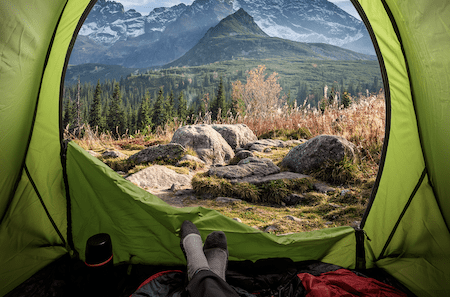If you’re a regular camper, you know really well how badly it can affect the lifespan of your tent when you have to put it on hard surfaces on a regular basis. And that’s where the necessity of a tent footprint comes in.
A tent footprint works as an extra layer of protection underneath your tent’s floor to protect it from moisture, abrasion, and ‘wear and tear’.
However, size matters with tent footprints, and you have to be careful to get an accurate tent footprint by size.
Otherwise, your camping trip may get spoiled due to the wrong sizing choice.
So, if you are wondering how to choose the right size tent footprint, we are here to help. In this article, you will get to know everything about this matter in detail.
Let’s jump into it.
Tent Footprint By Size: How Big They Should Be
Your tent footprint size depends on your tent size and how much ground the tent is covering.
You’ll probably be surprised, but tent footprints should be smaller than your tent. How small? We’re getting to that part.
Covering a big chunk of area (maybe even the parts your tarp can’t reach) with footprints can sound like a good idea, but it isn’t.
Tent footprints don’t work that way, and it does more harm than good.
The core idea for using a tent footprint is the extra waterproofing benefit.
You’ll have to be careful with the sizing so the water doesn’t pool near your tent.
Your tent footprint is something that should be keeping your floor dry, and that’s why you should choose a smaller footprint than your tent floor.
Your footprint should be at least 1-2 inches smaller (on all sides). It makes sure that your floor won’t be wet because of the muddy ground.
You can guess your floor size and go on to buy your tent footprint by size with that measure. The problem with getting an estimated measure is it won’t give you the accurate one.
There will be chances of you messing up the measures and getting the wrong size, so we recommend measuring your floor correctly before buying a tent footprint.
Here’s a sample chart according to the available footprint sizes available in the market.
| Tent Capacity | Footprint Size |
|---|---|
| 2 Person | 7’2″ x 4’8″ |
| 3 Person | 7’2″x 6’2″ |
| 4 Person | 8’2″ x 7’2″ |
| 6 Person | 9’8″ x 9’8″ |
| 8 Person | 15'8" x 6'8" |
If you’re using bigger tents, measure your floor first and ask for a 1-2 inches smaller footprint.
You can save yourself a little trouble and look for pre-made tent footprints instead. Some companies have specific tent footprints for particular tents.
You can be product-specific and look for specific tent footprints by size.
If you have absolutely no idea about your tent floor, you can ask the people running the tent shop.
Just tell them how many people you’ll use the tent for, and they’ll help you out.
The tent footprint should be around 2 inches smaller than your tent ground on all sides.
You have to measure your floor before getting the footprint to get the sizing right. If you don’t want to go through the measuring process, you can look for tent-specific footprints.
And if you aren’t sure about the floor size, you should ask the shop for help.
The shop will get you an estimated size tent footprint for your tent.
Estimated measures will be less accurate, so you can need some extra tuck-in or stitching to get the right size footprint for your tent.
What If You Can’t Find The Right Size Tent Footprint?
Most manufacturers have an array of tent footprints in different sizes, so you not finding a tent footprint is slim.
But if you can’t find one, you can either get the one closest to your measure or look for alternative materials (including things that involve a little DIY).
If you can’t find a suitable tent footprint by size for your tent, your first option is to buy the one with the closest measures.
It usually works just fine if the difference between measurements is smaller than 2 inches.
If the tent footprint is smaller than your original measure by more than 2 inches, it loses the whole purpose of using tent footprints.
It will be too short to save your tent from the rain and too short for saving the tent floor from the rough ground.
What if the tent footwear is too big? Well, it will bring more water into your tent than before.
So, the tip here is to buy a smaller footprint always. If you can’t find the exact measure, then get the one with the closest measures but make sure it is still smaller than your tent.
However, if you’re getting a bigger tent footprint than your tent floor, you’ll have to do some extra hassle to get it in shape.
You’ll have to fold the footprint on all sides and staple them close, so the extra part doesn’t sneak out and cause disaster.
When folding the footwear, make sure you’re grabbing an equal amount from the sides.
If you don’t want to take all that risk, you can look at alternative methods of a tent footprint.
Footprints come in different materials to look for the same footprint in additional material.
If you can’t find anything, you can make your tent footwear from the tarp. There are other alternatives available for this.
You can use Tyvek or Polycro to make your tent footprint.
The problem with Polycro and Tyvek is that you’ll have to cut it in the size you want yourself.
Stores usually don’t have pre-cut pieces of these materials to make your tent footprint by size and will rarely let you buy a piece.
You’ll either have to buy a full roll or look elsewhere for scraps to work with.
You can get Tarp in any size, but Tarp is pretty heavy. So Tarp may not be the option for you.
Why You Should Use A Tent Footprint
If you’ve been wondering why you need to use a tent footprint and what benefits it’ll bring you, here are the answers.
#1. Extra Protection
If you go on camping or hiking trips pretty often, you’ll know how important getting more protection is.
Of course, the footprint doesn’t protect your whole tent, but it saves your groundsheet from giving up too soon.
Most campers use lightweight tents for easy packing. Lightweight tent manufacturers sometimes use a lower Denier (unit for measuring the thickness of the tent material) to keep the tents lightweight.
Since the denier factor is lower, the tent ground can be easily worn out from the abrasive camping sites and possibly sharp rocks.
A tent footprint can add more protection to your tent floor because they are made of higher Denier materials.
Tent footprints will also protect your tent floor from the surface you’re camping at and other sharp objects.
It means you won’t have to worry about your tent floor ripping or getting other damages, and your floor will wear out slower.
#2. Extra Waterproofing
It’s the main appeal of using a tent footprint. Tent floors are usually waterproof, so adding a tent footprint by size means the water-resistance of your tent will be higher.
The tent floors for regular lightweight camping tents are pretty good at resisting water.
Most of them come with 3000-5000mm Hydrostatic Headrest units. A Hydrostatic Headrest unit is a unit, and it tells you how long your tent fabric can hold up before letting water in your tent.
As you can tell, the floors are pretty sturdy on their own but adding a tent footprint means the resistance gets almost doubled.
Tent footprints are made of very durable fabric. Most of the time, they’re the same as your tent floor.
Since the tent footprint has a high Hydrostatic Headrest unit count, the water resistance of your tent will be better with it.
You won’t have to worry about waking up to a wet floor after sleeping through the rain.
#3. Better Cleanup
Having an extra layer is better for keeping the tent floor clean.
If you’re camping on a site that has a muddy surface or can get muddy in the rain, your tent floor will pick up all that dirt unless you’re using a little extra layering to protect it.
A tent footprint is that extra layer between the ground and your tent floor.
If you’re in a muddy area, the tent footprint will ensure your tent isn’t picking up any dirt or mud from the ground.
So, tent footprints are pretty much a staple if you’re camping in the regions.
What To Consider Before Choosing A Tent Footprint
Tent footprints aren’t obligatory, but it is a good investment if you can pick the right one.
The key here is choosing the right one, whether selecting the tent footprint by size only or weighing other factors.
If you’re worried about getting your money’s worth from the tent footprint you’re getting, you should consider other things with the footprint size.
Here is a list of things you should consider when choosing tent footprints.
#1. Size Of The Footprint
Size is the most crucial factor when you’re picking your footprint. Your tent footprint will depend on the amount of ground your tent will cover.
If the footprint is too small, it won’t give you the protection you bought it for, and if it is too big, it can drag more problems in than before.
The tent footprint must be 1-2 inches smaller than your groundsheet.
If you’re buying a bigger footprint, you’ll have to either trim it to the exact size or fold it in to ensure the size won’t create any problems.
#2. Footprint Material
Footprint materials are all very durable, but if you’re planning to be on the move, you’ll have to consider their weight.
This is why the footprint material is important. The most common footprint materials are nylon, polyester, and Oxford fabric.
When you’re choosing a tent footprint, you’ll have to weigh out the pros and cons of the materials.
All three of these are synthetic materials. If you’re more into sustainable options, you can keep that in mind.
If you’re DIY-ing your tent footprint, you’ll have to be more careful.
Consider the durability and the weight of the material you’re choosing. If everything works out for you, go ahead with your tent footprint material.
#3. Durability
The whole point of getting a tent footprint is to protect the groundsheet from damage and rain.
Durability and water resistance will tell you how much your footprint will hold out against everything.
Denier number is the shortcut to knowing how durable the footprint material is.
A high Denier number means the material is thick and durable, and a lower Denier number means the opposite.
The number will be different in different footprint materials, so only compare the Denier number of the same material footprint.
Rip-stop is another term for durability. If a tent footprint says it uses rip-stop technology, the material is more durable and less like to get ripped.
#4. Water Resistance
Picking tent footprint by size is the first step toward water resistance, but there are other things you should consider.
Water resistance depends on the material and the proofing. Some materials are more resistant to water than others.
One way of knowing your tent footprint’s water resistance is to look at the Hydrostatic Headrest unit of the material.
The hydrostatic Headrest unit tells you how much your tent footprint material can put up against the water.
A higher number means more resistance, so the footprint will resist water longer before letting it in.
Most footprints come with a 3000-5000mm Hydrostatic Headrest unit, so check the label.
Another factor is the proofing material of the footprint. Manufacturers use either silicone proofing or Polyurethane proofing to make the material water-resistant. Silicone-proofing is more resistant, but it’s less breathable.
It will also cost you more. Polyurethane is more breathable and cheap.
If you’re looking to save a few bucks, go for Polyurethane.
#5. Cost
The cost for your tent footprint will depend on what material it is made of.
The proofing material is also another fact in footprint price.
Look around before buying the footprint you want. Make sure the price aligns with the quality and falls within your range.
How To Set Up A Tent Footprint
Setting up a tent footprint is very easy. It is just two extra steps before setting up your tent, so you don’t have to worry about complex processes.
Step 1
Put down your tent footprint on your tenting spot. You have to put the water-resistant part up.
The water-resistant part is usually the brighter side, but check the label for pointers if you can’t decide.
Secure the footprint to the ground. You can use tapes, but it is better to use some weight for securing it down.
Step 2
Connect the footprint grommets to your tent. Make sure they’re above the tent’s body grommets.
It will attach the tent footprint more firmly to shift the whole tent quickly when you want. If the footprint comes with straps, secure them properly.
Pitch your tent over the footprint and set it up. Tuck in any extra footprints you have and center your tent. And you’re done!
DIY: Make Your Own Tent Footprint From A Tarp
You can make your own if you’re done exhausting all tent footprint options or can’t find the right tent footprint by size.
Sure, the quality will be different from the manufactured ones, but what serves you the best.
Step 1: Measure Your Groundsheet
Your tent footprint depends on the size of your tent, so measure out the amount of ground the tent is covering.
Set up the tent and measure its bottom if you can’t figure it out from the packaging.
Step 2: Cut The Tarp
Lay out your tarp on the ground and mark 1-2 inches less than your original tent bottom measures on all sides.
Follow the marking and cut the tarp to shape. You can secure the seam with a round of sewing if you want, but that’s unnecessary.
Step 3: Add Grommets And Straps
Circle the part where you want the grommets to be. Cut holes, attach the grommets to the tarp, and ensure they’re secured.
You don’t need a fancy grommet kit for attaching. Get a cheap one, and it will work just fine.
Get some extra tarp from your roll and cut them to make straps. Fold the straps in half and attach the straps to your footprint cutout.
Your tent footprint is now done. Check the grommets and the straps before you start using the footprint all out.
Frequently Asked Questions
What Are Tent Footprints Made of?
Tent footprints come in lots of different materials. Most tent footprint uses polyester, nylon, or oxford fabrics.
The fabrics are then proofed with other materials to make them water-resistant. The proofing materials are either silicone or Polyurethane.
Why Are Tent Footprints Worth The Spending?
A tent footprint can protect your tent, increase the life of your tent and make things more convenient for you.
A tent footprint will save your groundsheet from wearing off too quickly and add extra water resistance. It will help your tent pick up less dirt or mud if you’re camping in a wet region.
Cleaning is more convenient with a tent footprint, but do you know the best part?
You don’t have to replace them often. So you can get a tent footprint and stop worrying about it for a long time.
3. How Much Does A Tent Footprint Cost?
Footprint cost depends on the material and the footprint you’re getting. Bigger footprints will cost you more.
Silicone-proofed or highly durable materials have a higher price tag than the others.
The average cost for getting a tent footprint by size is around $40-$60.
The cost will go up if you’re getting a bigger footprint for a bigger tent.
Conclusion
And here you have it, a full guide on picking tent footprint by size.
Material, durability, and water resistance are the most important factors when choosing a footprint for your tent. Another factor is the cost.
The cost will be different depending on what material your tent footprint is.
Good quality tent footprints will cost you more, but the investment is worth it.




